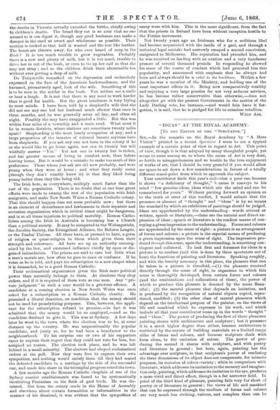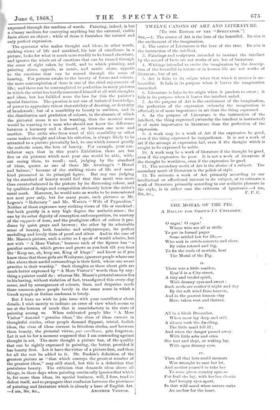" IDEAS " AT THE ROYAL ACADEMY. [To THE EDITOR
OF THE " SPECTATOR."]
SIR,—In the remarks on the Royal Academy by " A Mere Visitor" printed in a recent Spectator I seem to see a typical example of a certain point of view in regard to Art. This point of view, though it is that adopted by many thoughtful people, yet seems to some among us, to whom the cause of Art is very dear, so fertile iu misapprehension and so hostile to the true enjoyment of works of art, that I should be very grateful if you would allow me space to set down a few considerations in favour of a totally different stand-point from which to approach the subject.
Your contributor finds this year's collection a poor one because it shows " a deficiency of thought," because it conveys to his mind " few genuine ideas, ideas which stir the mind and can be remembered for years." Without putting forward an opinion as to the truth or error of this verdict, I would submit that the presence or absence of " thought" and " ideas " is by no means the standard by which an exhibition of paintings should be judged. Ideas are apprehended by the understanding : words uttered or written, speech or literature,—these are the natural and direct ex- pression of ideas ; speech or literature is the readiest means of con- veying a given impression to the understanding. Forms and colours are apprehended by the sense of sight : a picture is an arrangement of forms and colours ; a picture is the especial means of producing a given impression upon the sense of sight. The impression pro- duced through this sense, upon the understanding, is something con- tingent and collateral. To look first and foremost for ideas in a picture is to. confuse (and this is done by three spectators out of four) the functions of painting and literature. Speaking roughly, and with the brevity necessary in this place, the pleasure that can be taken in a picture is threefold, —(1) the pleasure received directly through the sense of sight, in organisms in which this sense is thoroughly developed, from certain forms and colours (aud the combinations and collocations of these), the power of which to produce this pleasure is denoted by the name Beau- tiful ; (2) the mental pleasure that depends on imitation, and is produced by the recognition of natural objects copied, repro- duced, modified ; (3) the other class of mental pleasures which depend on the intellectual purpose of the painter, on the views of life and mankind which he expresses in his work, and which include all that your contributor sums up in the words thought " and "ideas." The power of producing the first of these pleasures painting shares with architecture and sculpture ; but it possesses it in a much higher degree than either, because architecture is restricted by the nature of building materials to a limited range alike of forms and colours, and because sculpture deals with form alone, to the exclusion of colour. The power of pro- ducing the second it shares with sculpture, and with poetry and literature in general ; but here, again, painting has the advantage over sculpture, in that sculpture's power of rendering the three dimensions of its object does not compensate, for mimetic purposes, its omission of colour-variety ; while in comparison with literature, which addresses its imitation to the memory and imagina- tion only, painting, which addresses its imitation to the eye, produces a more vivid aud direct effect, though in a far narrower field. In point of the third kind of pleasure, painting falls very far short of poetry or of literature in general ; the views of life and mankind that can be expressed through the medium of forms and colours are very much less striking, various, and complete than can be
a clumsy medium for conveying anything but the external, visible facts about an object ; while of these it furnishes the natural and expressed through the medium of words. Painting, indeed, is but only perfect expression.
The spectator who makes thought and ideas, in other words, striking views of life and mankind, his test of excellence in a picture, looks for what is much more readily to be found elsewhere, and ignores the whole set of emotions that can be roused through the sense of sight taken by itself, and to which painting, and painting alone, appeals, as music, and music alone, appeals to the emotions that can be roused through the sense of bearing, For persons awake to the beauty of forms and colours, the mere contemplation of these is one of the chief enjoyments of life; and these can be contemplated to perfection in many pictures in which the artist has hardly concerned himself at all with thoughts and ideas, but has fulfilled none the less for this the painter's special function. The question is not one of technical knowledge, of power to appreciate this or that subtlety of drawing, or dexterity of brushwork; but of a sensibility to beauty in outlines, and in the distribution and gradation of colours, iu the absence of which the pictorial sense is no less wanting, than the musical sense would be wanting to a man who should not know the difference between a harmony and a discord, or between one note and another. The critic who from want of this sensibility or other cause makes thought and ideas his criterion, is always likely to be attracted to a picture pictorially bad, to one which cannot gratify the aesthetic sense, the love of beauty. For example, your con- tributor says that in this year's Exhibition there are but five or six pictures which next year one would be able, with- out seeing them, to recall ; and, judging by the standard of ideas, quotes as one of these Mr. Artnitage's " Herod and Salome," because of the striking views of life and man- kind presented in its principal figure. But any one judging by the standard of beauty would feel that this merit was more than counterbalanced in the picture by its distressing colour, and by qualities of design and composition obviously below the artist's usual mark. Moreover, he would note as works to be remembered not next year only, but for many years, such pictures as Mr. Legros's " Refectory " and Mr. Watts's " Wife of Pygmalion." Neither of these expresses very striking views of life or mankind ; but both gratify in a very high degree the aesthetic sense ; the one by its sober dignity of conception and composition, its mastery of the rapports of tone, and the prodigious effect of colour it pro- duces by quiet greys and browns ; the other by its admirable sense of beauty, both feminine and sculpturesque, its perfect modelling and lovely tints of pearl and silver. And in the case of Mr. Mason's picture, such a critic as I speak of would admire, but
not with " A Mere Visitor," because each of the figures has " a peculiar entrain, which grows and grows as you look till you hear the ' Keep me, oh, keep me, King of kings ! ' and know as if you knew them that those girls are Wesleyans, ignorant people whose one idea above their sordid surroundings is their faith, whose one sweet practice is their worship." Such thoughts as these about girls are much better expressed by "A Mere Visitor's" words than by any- thing a painter could do ; whereas Mr. Mason's pictorial success lies in his having, without violation of fact, transfigured this every-day scene, and by arrangement of colours, lines, and draperies made these common-place people lovely in the same sense in which a Greek nymph or Italian madonna is lovely.
But I have no wish to join issue with your contributor about details, I wish merely to indicate an error of view which seems to me at the bottom of much that is unsatisfactory in the state of painting among us. When cultivated people like " A Mere Visitor" demand "genuine ideas," the class of ideas current in thoughtful circles, other people demand flippant, trivial, foolish
ideas, the class of ideas current in frivolous circles, and between them beauty, the pictorial virtue, par excellence, gets forgotten.
Let it not be for a moment supposed that I am contending against thought in art. The more thought a picture has, of the quality that can be rightly expressed in painting, the better, provided it has beauty first. Let it have the virtue of a picture first, and then let all the rest be added to it. Mr. Ruskin's definition of the greatest picture as "that which conveys the greatest number of the greatest ideas," may still stand, but this is a definition that postulates beauty. The criticism that demands ideas above all things, in these days when painting continually ignores that which
is, far more than ideas, its special business, will, I fear, tend to defeat itself, and to propagate that confusion between the provinces of painting and literature which is already a bane of English Art.



































 Previous page
Previous page